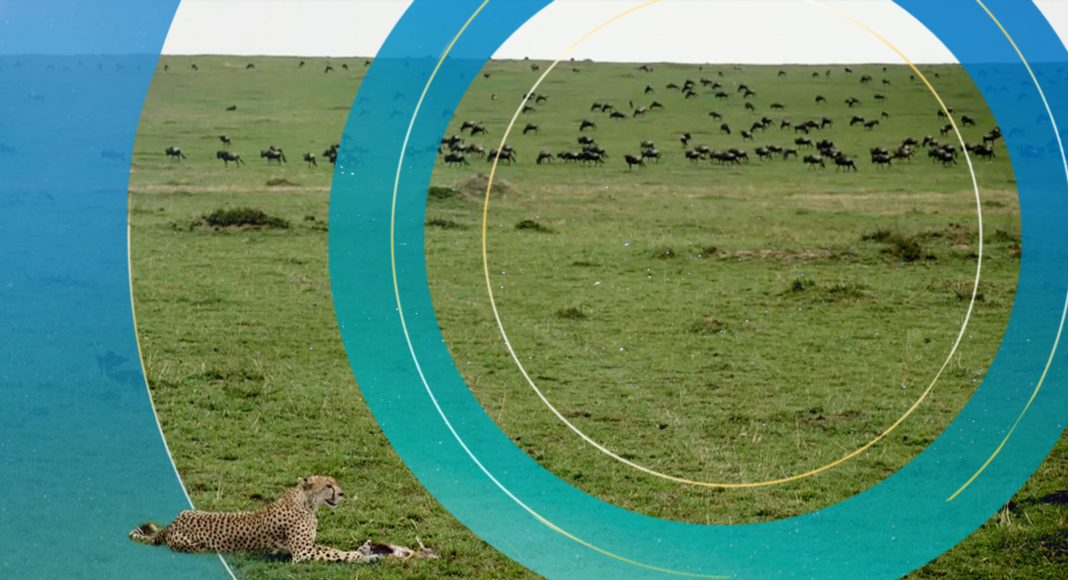It is one of the most spectacular sights in the animal kingdom. Anyone with even a passing interest in wildlife will be familiar with the scene.
Hundreds of thousands of wildebeest on their annual migration from the Serengeti in Tanzania across the border into Kenya’s Maasai Mara game reserve.
The iconic image of the wildebeest being picked off by hungry crocodiles as they attempt to swim across the Mara river is both instantly recognisable and utterly unforgettable.
Image:
Maasai villagers in Olareorok village
But this great migration is under threat from climate change. This year only a small fraction of the animals have come looking for fresh pasture in the Mara. The rains have failed and great swathes of the usual lush green grass is reduced to a scorched thatch. The uncertainty of finding food has kept most of the giant herd behind in Tanzania.
Image:
Climate change is threatening the iconic migration of wildebeest across the Maasai Mara
This could have a profound impact on the Maasai Mara’s fragile ecosystem. The wildebeest are an essential part of the food chain.
Saitoti Silantoi is from the Maasai tribe. He was born and raised in the Mara. He is also a scientist and a conservationist. Few people are better qualified to talk about the impact of global warming on this part of Kenya.
“When I was a young boy I remember all I could see was an endless mass of black as far as the eye could see,” Saitoti tells me.
Describing the sight of hundreds of thousands of wildebeest stampeding across the plains he recalls the thunder of hooves and the snorting of the animals as defeaning.
We are walking through the long dry grass towards a herd of wildebeest grazing alongside zebra, topi antelopes and impala. It is an incredible sight but nothing compared to what Saitoti has seen as a young man growing up in this wilderness.
Image:
Saitoti Silantoi of the Mara Predator Conservation Association
Saitoti is a researcher for the Mara Predator Conservation Project. His special interest is in the apex predators that hunt in the Mara. This game reserve has lions, leopards, cheetahs and hyenas.
He tells me: “The annual wildebeest migration serves a very vital role in the Masai Mara because, you know, they bring that bulk food that predators need. So if you cut out this main source of food, then basically, the predators would not make it you know especially the lions and the hyenas.”
Saitoti has no doubt that man is responsible for causing this environmental damage. He has this grim warning about the future of the Maasai Mara.
“You know if urgent action is not taken right now to cap the effects of climate change then we will definitely lose the Mara.”
The Mara river should be flowing fast. Instead the water levels are so low they can barely submerge the giant hippos that are trying to cool off in the water. One of the animals startled by our presence stands up quickly. The water barely reaches halfway up its legs.
Alex, my young safari guide, points to the tree line at the top of the bank on the other side of the river. “That’s how high the water usually gets,” he says.
The failed rains mean the Mara’s grazing animals are pushed to look outside the boundaries of the reserve for food. This means there is more potential for further human-animal conflict because the Maasai also need to find fresh pasture for their cattle.
Image:
Jackson Rakwa, a village elder
Jackson Rakwa is a Maasai elder. His older brother is the chief of one of the settlements that sits on the edge of the Mara reserve. There are a few metal outbuildings scattered around the camp where children stand in the shadows of the doorways, shy of the foreigners who have come to their home. Only Jackson and his brother have substantial brick buildings.
The cattle, part of a 400 strong herd, are mostly corralled behind stick and wire fences. The women are busy milking a few, while other children gently whip the loose ones back into their pens. The cattle are central to the Maasai way of life. They proe meat, milk and leather. They are also a source of income and a measure of wealth.
Image:
The cattle, part of a 400 strong herd, are mostly corralled behind stick and wire fences
“I lost 11 of my sheep to hyenas last week,” Jackson says mournfully. “It’s happening more and more. We get compensation but it’s not enough.” This is the danger of rearing livestock near such fearless and determined predators.
But what really worries Jackson is the change he has seen in the weather. The dry seasons are longer and the rains come less frequently he explains.
“If there’s no rain, soon we are going to lose a big, big number of cows, which is a problem to us and there’s nothing we can do about it. So we are just praying so hard for the rain to come.”
As we drive home from the village back to our lodge Alex spots a cheetah by the roadside. We stop our car just a few feet away. The big cat is panting heavily. It has just made a kill. The remains of what is clearly a newborn gazelle lie in the grass next to it.
Vultures circle overhead.
The cycle of life and death looks brutal but it is nature’s way of keeping the balance. But the animals in the Maasai Mara are powerless to stop the causes of climate change. Their survival very much depends on man.




